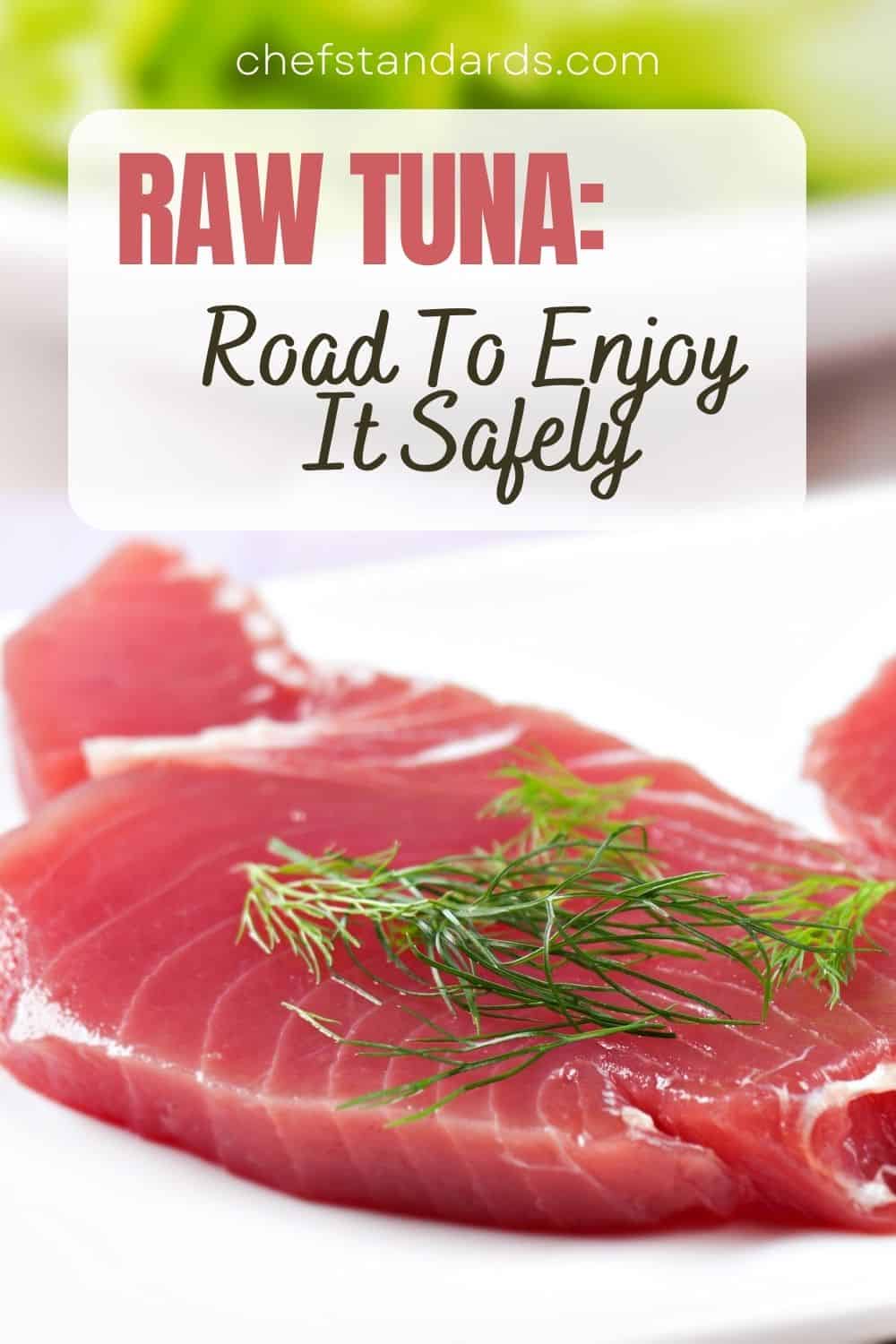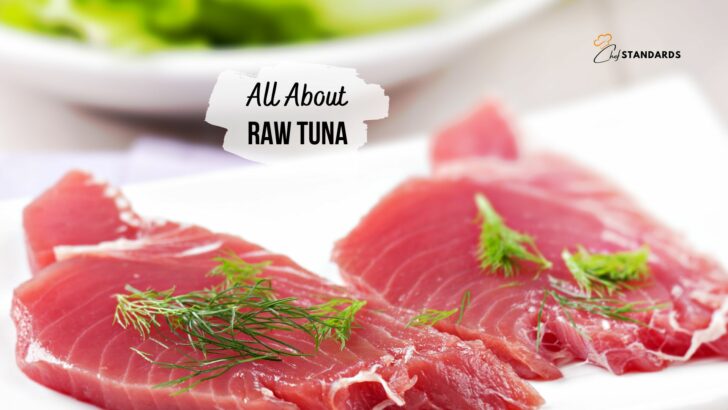Among various types of fish, and there are many of them, tuna remains one of the most popular.
There are many reasons for that, but the most important one is its high nutritional value.
Another reason is the fact that tuna can be eaten raw and, in this form, it is quite delicious if you know how to prepare it.
From that, the question of handling raw tuna arises, as well as some questions about safety issues when doing so.
In this article, I will try to present to you all the important facts about raw tuna, its benefits, handling and preparing methods, and also some potential risks you need to be aware of.
Raw Tuna And Its Types
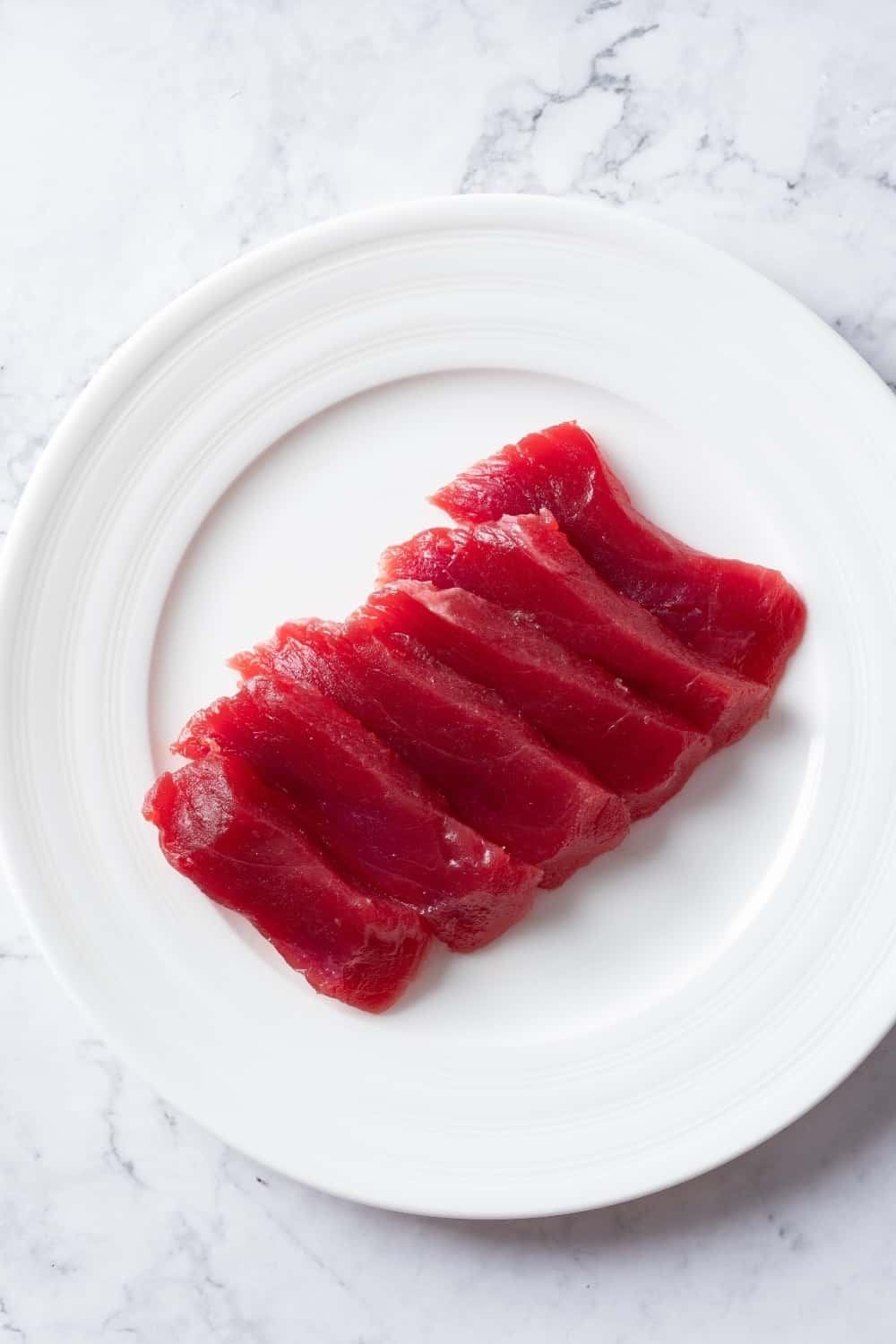
First, let’s see what type of fish tuna really is.
Well, tuna is a large, saltwater fish that belongs to the family Scombridae, which also includes other species such as mackerel and bonito.
Tuna are generally known for their torpedo-shaped bodies, which are designed for speed and efficiency when swimming through the ocean.
They are typically found in warm waters throughout the world’s oceans, although some species are found in cooler regions as well.
Various Types of Tuna
Although it is becoming immensely popular all over the world, tuna is mostly used in Japanese cuisine, and the types used there are the most popular ones. So, here are some of the most popular types of tuna used in that part of the world.
• Bluefin Tuna: Bluefin tuna is one of the most prized and expensive types of tuna. It has a deep red color and a rich, buttery flavor. Bluefin tuna can be further broken down into three subtypes: Pacific, Southern, and Atlantic.
Due to its larger size and superior flavor, the Atlantic bluefin tuna is the most sought-after type of bluefin tuna.
• Yellowfin Tuna: Another popular type of tuna is the so-called yellowfin tuna. It is often used in Japanese dishes, sushi, and sashimi. It has a lighter pink color than bluefin tuna and a milder, slightly sweet flavor.
Those of you who are more familiar with this type of fish have probably heard about Ahi tuna. Well, that is actually another name for yellowfin tuna, which is often used in many parts of the world, particularly in Hawaiian cuisine.
• Albacore Tuna: Albacore tuna, also known as “white tuna”, is a mild-flavored tuna that is often used in canned tuna fish products. When consumed raw, it has a light pink color and a tender texture.
• Bigeye Tuna: Bigeye tuna is a larger species of tuna that is similar in flavor and texture to yellowfin tuna. It has a slightly deeper red color and a firmer texture.
• Skipjack Tuna: Finally, skipjack tuna is a smaller species of tuna that is often used in canned tuna fish products. It has a mild flavor and a light pink color.
Benefits Of Eating Raw Tuna

As I already said in the introduction part, tuna is one of the healthiest types of fish out there. And raw tuna is even healthier and more nutritious because those nutrients are not affected by the high heat during the cooking process.
To begin with, raw tuna is relatively low in calories, making it a good option for those of you who are watching your calorie intake.
When eaten raw, this type of fish can be an excellent source of protein, and you all know that proteins are extremely important for building and repairing tissues in the body, as well as for many other important bodily functions.
In general, fish is a great source of healthy fats, and raw tuna is exceptionally high in omega-3 fatty acids, which are essential fats that our bodies need but can’t produce on their own.
It has also been proven that omega-3 fatty acids are very good for fighting inflammation in the body, and they are also good for your heart health, as well as brain energy.
Finally, raw tuna is rich in various vitamins and minerals. Some of the most important ones include vitamin D, vitamin B12, and selenium.
Vitamin D is essential for bone health and overall immune function, and it plays a role in the functioning of almost every cell in the body.
Vitamin B12 is very important for the production of red blood cells, while selenium is an antioxidant that protects the body from damage caused by free radicals.
Nutritional facts about 1 serving (1 oz or 28g) of boneless raw tuna is presented in the table below. (1)
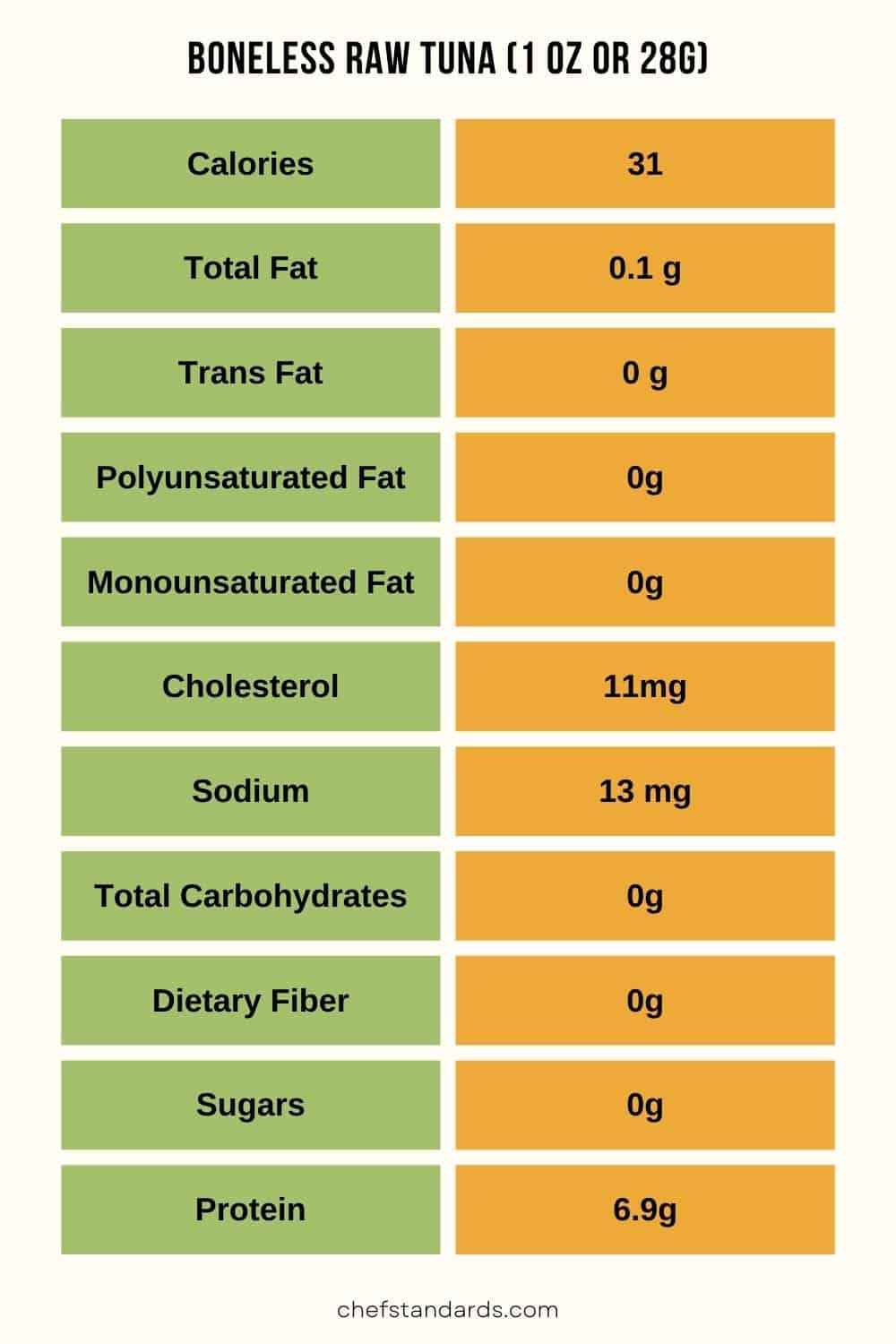
As you can see, there are numerous health reasons to incorporate some raw tuna into your eating schedule.
However, I also have to emphasize that there are certain risks as well, especially if you don’t handle raw tuna properly, and if you don’t eat it in moderation.
Potential Risks

Whatever we do in life, there are some potential risks we need to be aware of. And eating food, especially fish, is no exception. So here I will present to you some of the major risks when it comes to eating tuna raw.
• Parasites: In general, raw fish may contain parasites, such as Opisthorchiidae and Anisakadie, that can cause diseases in humans.
Depending on the exact type of parasites, consuming them inside raw fish can easily lead to foodborne illnesses, marked by intestinal infections that trigger diarrhea, vomiting, fever, and other related symptoms.
• Harmful Bacteria: Aside from parasites, there is a high risk for raw tuna to contain harmful bacteria, especially if it hasn’t been handled the right way.
These can include bacteria such as Salmonella, Listeria, and Vibrio, which can also lead to foodborne illnesses, and the symptoms include nausea, vomiting, diarrhea, and fever.
• Mercury Poisoning: Mercury is a toxic heavy metal that winds up in ocean waters due to pollution.
Tuna lives in those ocean waters and, since it is relatively high in the food chain, feeds on smaller fish that contain varying amounts of mercury.
Because of that, some large species of tuna, such as yellowfin, albacore, bigeye, and bluefin, are often high in mercury.
If consumed in higher amounts, this toxic heavy metal can cause serious neurological damage, especially in developing fetuses and young children.
• Allergic Reactions: Some people may be allergic to tuna or other types of fish, which can cause symptoms such as hives, swelling, and difficulty breathing.
So, if you know that you have a fish allergy, it is best that you avoid consuming raw tuna or any other type of fish.
• Environmental Contamination: Tuna can also be exposed to environmental contaminants such as polychlorinated biphenyls (PCBs) and dioxins, which can accumulate in the fish’s tissues.
These contaminants can be very dangerous and have been linked to several health problems, including cancer and delays in developmental.
Who Should Avoid Eating Raw Tuna?
If the raw tuna is 100% free from any parasites, bacteria, or any other contaminant, there is no problem with consuming it. However, most of the time, we are not sure.
To avoid getting into serious trouble, some people should avoid eating tuna raw. This is especially the case with small children, older adults, and breastfeeding women.
Also, if you have some serious health issues or a compromised immune system, such as undergoing cancer treatment, it is best to avoid eating raw tuna.
Namely, people in this category have a higher risk of getting foodborne illness if exposed to parasites or bacteria from raw or undercooked tuna.
Besides that, mercury poisoning can be extremely dangerous for children and breastfeeding women because it can seriously disturb the process of a child’s development.
Also, the general population should consume raw tuna in moderation. For healthy adults, it is best to consume 3-5 ounces (85 grams) of fish 2-3 times per week to achieve the best nutrition results.
How To Be Safe And Sound When Eating It?

Although there are risks, there are also ways to minimize those risks. First, you need to know how to choose the best tuna on the market, as well as how to handle it properly. So, let’s take a look.
Choosing The Best Raw Tuna
Choosing the best raw tuna is key to ensuring that it’s both safe to consume and offers the maximum nutritional benefits. Here are some tips to help you choose the best raw tuna.
1. Choose Fresh Tuna: When choosing raw tuna, always look for the freshest fish available. This means looking for tuna that has a bright, clear eye, firm flesh, and a pleasant smell. Avoid tuna that smells fishy or has discolored flesh or dark spots.
2. Check the Color: The color of the tuna can also be an indicator of its freshness. Look for tuna that has a deep red color, as this indicates that the fish has been properly handled and stored.
Avoid tuna that appears brown or gray, as this can indicate that it’s past its prime.
3. Choose The Right Species: There are different species of tuna and they all have different flavors and textures. Some of the most popular types of raw tuna include bluefin, yellowfin, and albacore.
Bluefin tuna is definitely a top choice since it is the most flavorful, but it is also quite expensive. In my opinion, yellowfin tuna is best because it is more affordable and, although a bit milder, still quite flavorful.
4. Look for Sustainable Options: Tuna populations around the world are under pressure due to overfishing, so it’s important to choose tuna that has been sustainably harvested.
Look for tuna that has been certified by organizations such as the Marine Stewardship Council (MSC) or the Monterey Bay Aquarium’s Seafood Watch program.
5. Buy from a Reputable Source: When buying raw tuna, always choose a reputable source that you trust. This can include local fishmongers, seafood markets, or online retailers that specialize in high-quality seafood.
Handling Raw Tuna Properly
When it comes to tuna, the safest choice is cooking it until it’s reached an internal temperature of 145 °F. However, since we are talking about raw tuna here, that is not an option.
Fortunately, there is a way to handle raw tuna and consume it safely. The secret lies in freezing, i.e. the special freezing methods.
According to The Food and Drug Administration (FDA), freezing tuna at very low temperatures can kill any parasites or harmful bacteria present in the raw fish, making it safer to eat.
So, here are their recommendations:
• Freeze tuna at an ambient temperature of -4°F (-20°C) or below for 7 days (total time).
• Freeze it at an ambient temperature of -31°F (-35°C) or below until solid and store at an ambient temperature of -31°F (-35°C) or below for 15 hours.
• Freeze at an ambient temperature of -31°F (-35°C) or below until solid and store at an ambient temperature of -4°F (-20°C) or below for 24 hours.
After the freezing process, you must defrost your frozen raw tuna in the refrigerator before consumption.
This is by far the best method for removing parasites from raw tuna, and most restaurants that serve sushi or other dishes with raw tuna, use it.
There are some other methods as well, but they are not as effective as the freezing method.
For example, brining and pickling may reduce the parasite hazard, but it does not eliminate it, nor does it minimize it to an acceptable level.
Also, trimming away the belly flaps of the fish or candling and physically removing parasites are effective methods for reducing the number of parasites.
However, they do not completely eliminate the hazard, nor do they minimize it to an acceptable level.
NOTE: You can also refreeze tuna the same way as you would refreeze salmon.
Ways To Prepare Your Raw Tuna
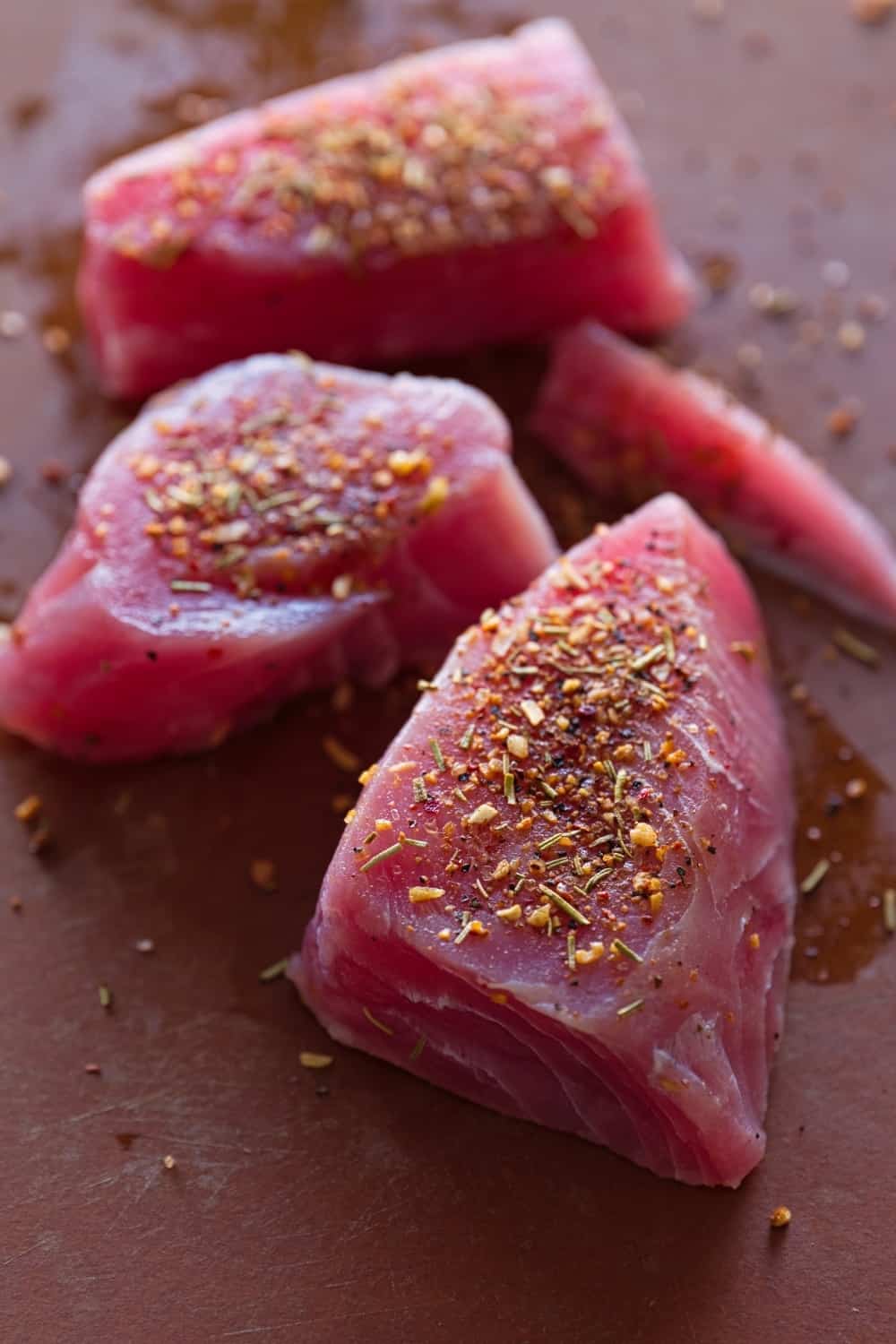
Now that you know everything you need to know about raw tuna, including the benefits and risks of consuming it, as well as the best ways to choose and handle it, it is time to learn what you can make of it.
• Sushi: Sushi is probably the most popular Japanese dish that consists of seasoned sushi rice combined with a variety of toppings, including raw fish such as tuna.
Some popular sushi rolls that feature tuna include tuna rolls (with sushi rice and seaweed), spicy tuna rolls, tuna avocado rolls, tuna and cucumber rolls, and negitoro rolls.
• Sashimi: Although not as popular as sushi here in the West, sashimi is a big part of Japanese cuisine. It is a traditional Japanese dish that consists of thinly sliced raw fish, including tuna.
Sashimi is typically served with soy sauce, wasabi, and pickled ginger, and can be accompanied by a variety of garnishes such as daikon radish and shiso leaves.
• Poke: This one doesn’t come from Japan, but that doesn’t make it less valuable. It is a Hawaiian dish that typically features cubed raw fish, including tuna, marinated in a soy sauce-based dressing and served over rice or greens.
Poke can also be customized with a variety of toppings, including avocado, cucumber, and sesame seeds.
• Ceviche: Ceviche is a Latin American dish that is made from raw fish marinated in citrus juice, typically lime or lemon.
Raw tuna can be used in ceviche recipes, either on its own or alongside other seafood such as shrimp or scallops.
• Tartare: Finally, there is a famous tartare. Tuna tartare is a dish that features finely chopped or minced raw tuna mixed with a variety of seasonings, such as soy sauce, ginger, and garlic.
The tuna can be served on its own or as a topping for crackers or crostini.
To Sum Things Up
In the end, there is not much left to be said. Raw tuna is very nutritious and can be delicious too if prepared the right way.
However, you must know that it also bears some risks, including potential contamination with parasites or harmful bacteria, high levels of mercury, as well as potential fish allergies.
Because of that, it is very important to choose the best tuna on the market, according to the guidelines discussed above and, if you want to eat it raw, use the freezing method, also explained in this article, according to FDA guidelines.
Sources:
1. Nutritionix, Raw Tuna, accessed 4 March 20232.
2. Healthline, Can You Eat Raw Tuna, accessed 4 March 2023
